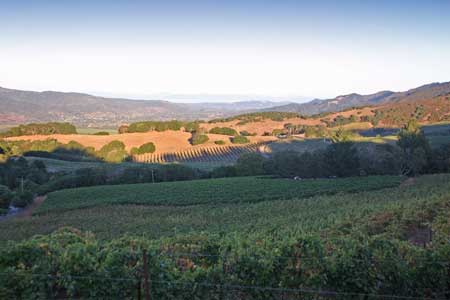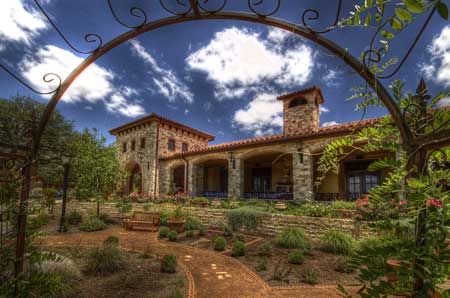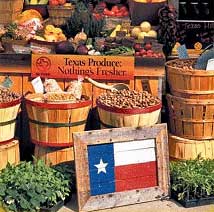
Drink Texas…Save “Food Miles” gives a new meaning to the saying…”Drink Responsibly”.
After a prolonged period of consistently low oil prices, we are now facing a new situation – an age where companies and countries around the world are competing for the remaining oil where increased prices are the expected norm in the future.
With the higher cost of filling the tank we are starting to think if that trip in the car really necessary. It should also be the same for the products we buy. The cost of fuel for transport has a significant effect on retail prices and the distance of travel also increases the amount of greenhouse gas pollution generated.
Example: What portion of your favorite New Zealand Sauvignon Blanc’s price is transportation? How much oil was consumed to bring it to your palate? How large is its carbon emissions “footprint”?
Let’s bring this discussion even closer to home…..the same questions (and logic) applies to foods and wines that come together on our dining room tables daily, even if they come from within the US. There is a siginficant fuel cost and carbon emission that is related to transporation from Washington State, Florida or California to our homes in Texas.
Many basic and “luxury” foods traverse long distances. This distance (and the associated fuel allocation and carbon emission) can be viewed in terms of “food miles” – See below for definition of Food Miles and how to calculate them. Therefore the closer to home these items are produced, the lower the food miles, and in turn, the more we reduce fuel burned and greenhouse gas pollution.
The concept is simply….Eat and drink well while responsibly reducing oil consumption and pollution by buying locally produced Texas food and wine, where and when possible.
Luckily in Texas we have a wonderful agricultural bounty and a Texas governmental agency that actually tries to promote locally produced food, wine and related agricultural goods.

Check out the consumer resources that the Texas Department of Agriculture’s GO TEXAN program provides at:
http://www.gotexan.org/gt/home/0,1223,1670_0_0_0,00.html
Find a restaurant that supports Texas food and wine:
http://www.gotexan.org/internet/gotexanrestaurant/search.jsp
Find a Texas winery and visit, attend an event or direct ship wine to your home:
http://www.gotexanwine.org/
Through October 19th, attend the Texas State Fair and see this Texas bounty first hand. Award-winning Texas wines will be poured. The Wine Garden, presented by Kroger and sponsored by the Texas Department of Agriculture, allows fairgoers the chance to explore the world of wine while meeting the people who have put the Lone Star State on the worldwide winemaking map. Findout why Texas is the fifth-largest wine producing state in the country, contributing $1.35 billion to the state’s economy.
At the Texas Wine Garden you can talk to real live Texas winemakers, attend “Wine 101” seminars, and sample FREE foods from Go TEXAN vendors. Also, visit the adjacent Food and Fiber Pavilion, presented by Borden.
The Texas Wine Garden, located on Nimitz Drive, is across the street from the Creative Arts Building and the historic Cotton Bowl. It is open noon to 7 p.m. every day of the fair through Oct. 19. Visitors are also invited to shop at the pavilion’s GO TEXAN stores.
+++++++++++++++++++++++++++++++++++++++++++

P.S. Want to calculate food miles?
The way to determine “food miles” is to simply look at the distance that food travels multiplied by its weight. Therefore, something like a watermelon can accumulate food miles fast due to its weight. Likewise, a case of wine also racks up food miles because it is also mostly water (like in watermelon). Even worse is a case of wine from New Zealand. It is so far that you can’t go any further without starting to come back.
Save food miles, drink Texan!

Well said
I understand you concept of food miles. However, if I am going to give up my favorite French or New Zealand wine, the important question is….Does Texas have something comparable to offer?
Not having had many Texas wines, please give me some of your suggestions as to wineries that produce the best wines.
Good question!
If you go back a couple of blog posts on VintageTexas, you will see the article “Texas Wineries go Mainstream”. This article references the new Parker Wine Buyer’s Guide (No. 7) that contains references to several Texas wineries.
This edition features six Texas wineries:
Alamosa Wine Cellars – http://www.alamosawinecellars.com
….Tempranillo
Becker Vineyards – http://www.beckervineyards.com
….Prarrie Rotie (Rhone blend), Claret, Res. Cabernet
CapRock Winery – http://www.caprockwinery.com
….Sangiovese
Inwood Estates Vineyards – http://www.inwoodwines.com
…..just about anything Spanish
McPherson Cellars – http://www.mcphersoncellars.com
…..Viognier, Tre Colores, dry rose
Sandstone Cellars – http://www.sandstonecellarswinery.com
…..Blend No. III
I few more to try are:
Llano Estacado Viognier and Cellar Select Merlot
Haak Vineyards Blanc du Bois (A French-American Hybrid; Dry or Sweet)
Hope this keeps you busy tastings and can reduce your allocation of food miles!
Me again.
I just did the calculation of food miles for a case of wine from New Zealand and one from Texas and it really blew my mind.
See below:
Case of Wine from New Zealand –
Distance – 7800 miles x 9 kg (9 liters) = 70,200 kg-miles
Case of Wine from Texas
Distance – 300 miles x 9 kg = (9 liters) = 2700 kg-miles
Now, that is mind blowing! More than 23 time the food miles of the Texas wine.
I am a believer! I will try some this weekend.
Thanks, Russ, for the good words about Texas. Local wine deserves more respect, which is why several wine writers have started DrinkLocalWine.com, with links to local wine writing around the country.
Jeff,
Thanks for the kudos. I am a believer in local food and wine and I think that Texas is really about to break into the “Bigs”. We are finally planting the right varietals and making wines for our hot weather. Texas is what I have called for a long time “The Medterranean of the USA”.
VT.com readers, please check out Jeff’s new site at:
http://www.DrinkLocalWine.com
I would like to add a fine Texas port – Sandtone Cellars IV. Messina Hof, Barking Rocks and Cross Timbers also produce a nice selection of varietals and blends, and for something rather funky and fun, La Buena Vida’s Redheaded Stepchild.
Me again…..I just got an email from someone that did not like my reference to food wiles in this blog posting. He felt like I should have used the term “drink miles”.
He is correct.
Russ
I believe there are close to 170 Texas wineries, so in response to the comment by FoodTexan. Yes, you should be able to find a nice wine in Texas.